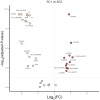The Omega-6 Lipid pathway shift is associated with neutrophil influx and structural lung damage in early cystic fibrosis lung disease
- PMID: 39286529
- PMCID: PMC11403467
- DOI: 10.1002/cti2.70000
The Omega-6 Lipid pathway shift is associated with neutrophil influx and structural lung damage in early cystic fibrosis lung disease
Abstract
Objectives: In cystic fibrosis (CF), an imbalanced lipid metabolism is associated with lung inflammation. Little is known about the role that specific lipid mediators (LMs) exert in CF lung inflammation, and whether their levels change during early disease progression. Therefore, we measured airway LM profiles of young CF patients, correlating these with disease-associated parameters.
Methods: Levels of omega (ω)-3/6 PUFAs and their LM derivatives were determined in bronchoalveolar lavage fluid (BALF) of children with CF ages 1-5 using a targeted high-performance liquid chromatography-tandem mass spectrometry approach. Hierarchical clustering analysis was performed on relative LM levels. Individual relative LM levels were correlated with neutrophilic inflammation (BALF %Neu) and structural lung damage (PRAGMA-CF %Disease). Significant correlations were included in a backward multivariate linear regression model to identify the LMs that are best related to disease progression.
Results: A total of 65 BALF samples were analysed for ω-3/6 lipid content. LM profiles clustered into an arachidonic acid (AA)-enriched and a linoleic acid (LA)-enriched sample cluster. AA derivatives like 17-OH-DH-HETE, 5-HETE, 5,15-diHETE, 15-HETE, 15-KETE, LTB4 and 6-trans-LTB4 positively correlated with BALF %Neu and/or PRAGMA %Dis. Contrastingly, 9-HoTrE and the LA derivatives 9-HoDE, 9(10)-EpOME, 9(10)-DiHOME, 13-HoDE, 13-oxoODE and 12(13)-EpOME negatively correlated with BALF %Neu and/or PRAGMA %Dis. 6-trans-LTB4 was the strongest predictor for BALF %Neu. 5-HETE and 15-KETE contributed most to PRAGMA %Dis prediction.
Conclusions: Our data provide more insight into the lung lipidome of infants with CF, and show that a shift from LA derivatives to AA derivatives in BALF associates with early CF lung disease progression.
Keywords: alveolar macrophages; cystic fibrosis; inflammasome; lipid mediators; neutrophils; translational immunology.
© 2024 The Author(s). Clinical & Translational Immunology published by John Wiley & Sons Australia, Ltd on behalf of Australian and New Zealand Society for Immunology, Inc.
Conflict of interest statement
The authors declare no conflict of interest.
Figures




References
-
- Cantin AM, Hartl D, Konstan MW, Chmiel JF. Inflammation in cystic fibrosis lung disease: pathogenesis and therapy. J Cyst Fibros 2015; 14: 419–430. - PubMed
-
- Sly PD, Gangell CL, Chen L et al. Risk factors for bronchiectasis in children with cystic fibrosis. N Engl J Med 2013; 368: 1963–1970. - PubMed
-
- Margaroli C, Horati H, Garratt LW et al. Macrophage PD‐1 associates with neutrophilia and reduced bacterial killing in early cystic fibrosis airway disease. J Cyst Fibros 2022; 21: 967–976. - PubMed
Grants and funding
LinkOut - more resources
Full Text Sources
Research Materials
Miscellaneous
